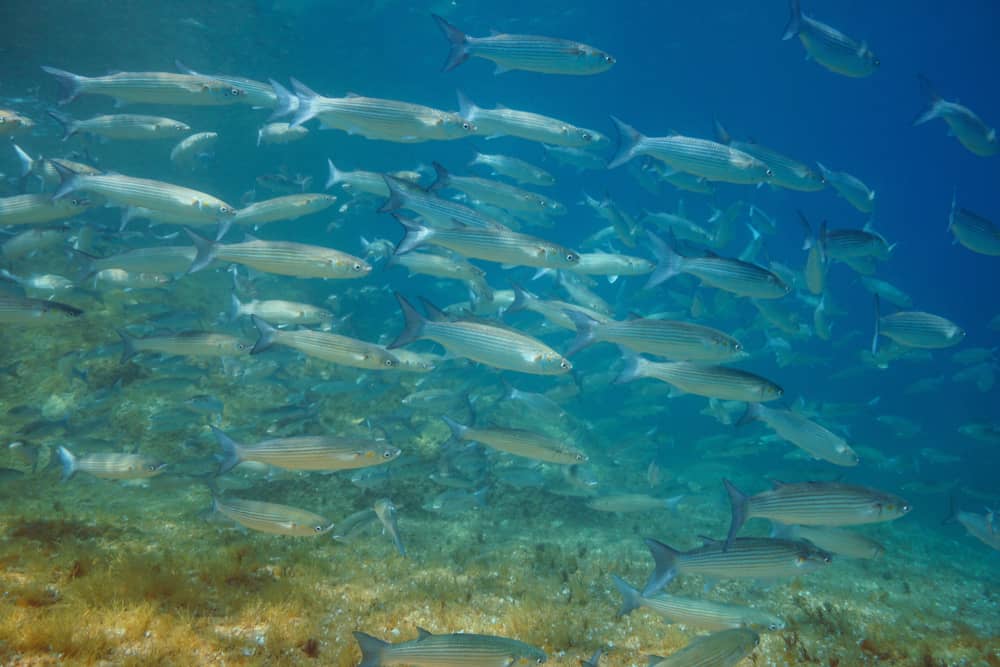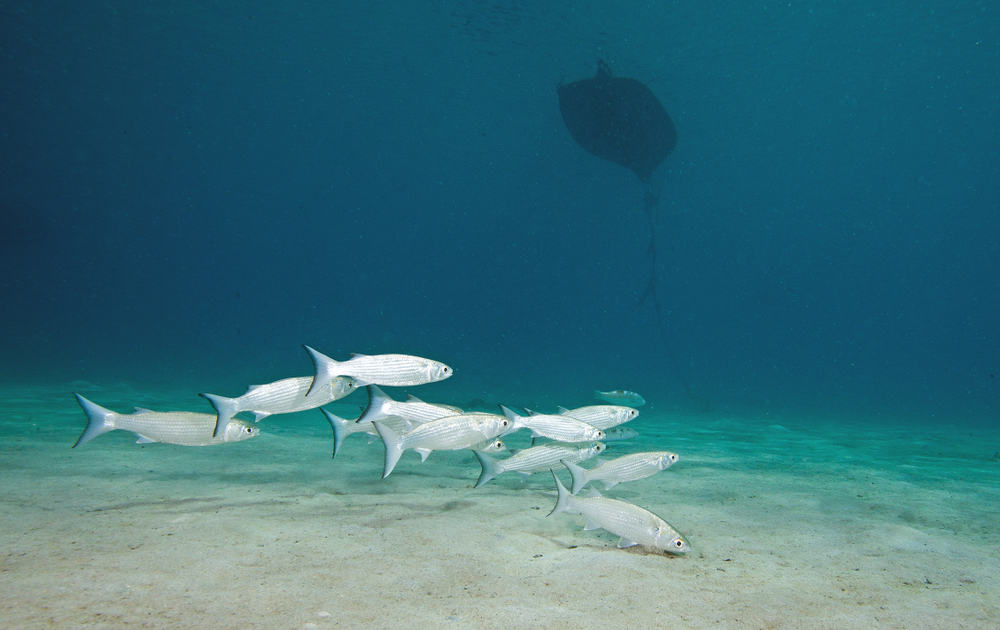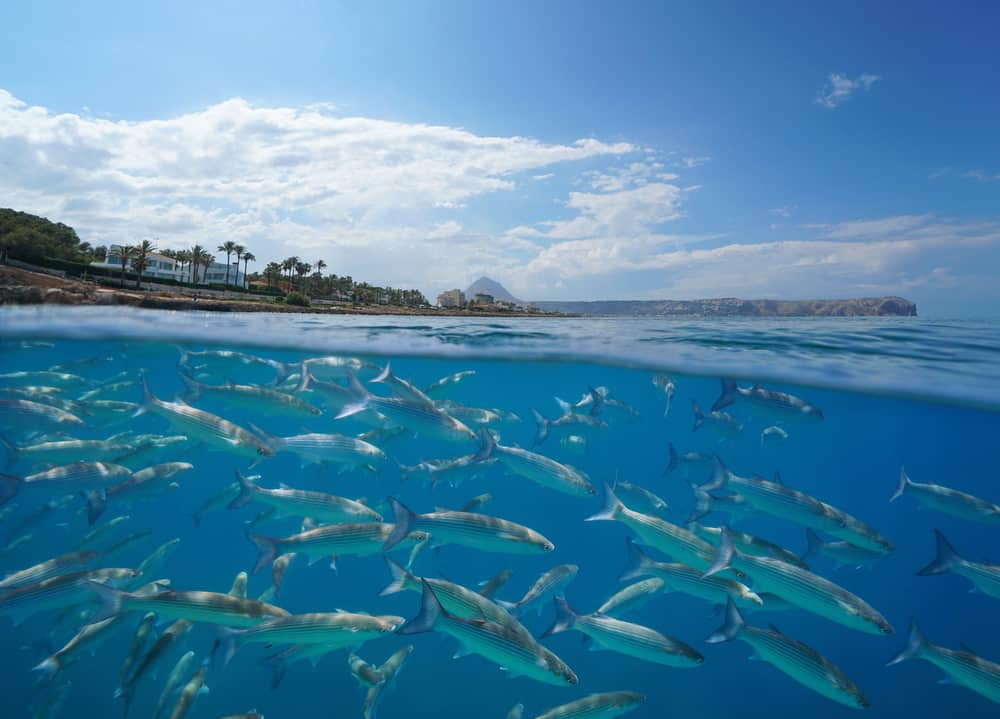Mullet is a common menu item in seafood restaurants. It offers delicious servings, which makes it a favorite among many seafood lovers.
But what does mullet eat that makes its meat so tasty? We are about to find this out and will also explore other facts that make this fish so fascinating. Let’s start!
Mullet Habits and Biology
Mullets are found all over the world particularly in tropical and subtropical zones both in estuaries and the open sea. There are over 100 species available but the most common are the striped mullet, white mullet, diamond scale mullet, sea mullet, and sand mullet.
The fish have a firm elongated body, which is silvery on the sides and dark bluish on the top. The majority weigh between 2 and 3 pounds but some species can weigh up to 7 pounds or more. Similarly, mullets rarely exceed 3 inches in length but there are some species that have been found to grow up to 2 feet tall.
Mullets start mating when they are 3 years old. Most of the time, they will spawn in shallow water, but they are times when they have been found to spawn up to 130 feet deep. The mating season will vary from species to species, with the majority mating in fall and winter.
A single female will lay between 1 and 7 million eggs in one season. The males will fertilize the eggs, after which the eggs will be left floating freely on the water, unguarded. While a huge number of eggs get preyed on by aquatic predators, there is still plenty that survives. These eggs hatch within a day or two, producing 2.4 mm fries.
Because mullets live in shallow waters, they are an easy target for the birds of prey, land-based animals, and marine predators. However, over the years, mullets have adapted several techniques to keep themselves safe in the water and ensure their survival.
For instance, they swim in groups called schools that help not only to keep predators at bay but also to find food quickly. They can also jump out of the water, and by doing this, the refraction of light on the surface makes it difficult for the marine predators to see the fish.
Here is a video that will help you better understand the life of mullets:
While it focuses solely on the Florida mullet, the facts are true for mullets found in other parts of the world as well.
What Do Mullets Eat in the Wild?
Mullets have tiny mouths, meaning, they will usually consume small food items. However, they love to eat and will feast on just about anything they bump into as long it fits inside of their mouths. They spend the biggest part of their day looking for food to get the nutrition they need to stay healthy.
Because of the wide range of areas they live in, changes in seasons, and differing water temperatures, mullets’ diet can change from time to time. But for the most part, they will feed on plants and small marine animals. They also love food provided by anglers.
What Do Mallets Like to Eat?
-
Small Plants
Mullets enjoy eating the tiny plants found on the floor of the ocean. They will nibble at diatoms, blue-green algae, filamentous green algae, green sea lettuce, and more. These fish usually don’t bite huge chunks of food; they will continuously nibble at their food sources until they have had enough.
-
Detritus
When plants die, they leave leftovers at the bottom of the sea. As time goes by, this waste changes into a compound called detritus and settles on rocks and other plants in the area. This compound together with the surrounding aquatic plants makes an excellent meal for mullets.
-
Small Insects
In addition to plants, mullets love insects and larvae. They have, especially, been found to love maggots, which explains why many anglers prefer to use maggots as bait to catch mullet. In the absence of maggots, mullets can also feed on ragworms. If you are an angler looking to catch mullets for dinner, these are some of the baits that will likely work for you the best.
-
Leftover Flesh
As we mentioned, mullets will feed on anything they find on their way provided it is munchable and can go inside their little mouths. Now, when they come across leftover flesh at the bottom of the ocean, they will feast on it without a second thought. They particularly love mackerel flesh.
If you plan on going fishing for mullets, you can carry mackerel flesh with you; just make sure it is skinless and cut into very tiny pieces.
Other food items that constitute mullets’ diet include:
- Epiphytes – small plants that grow on larger plants
- Polychaetas – seaworms
How Mullets’ Diet Benefits the Ecosystem
When detritus is in large numbers at the bottom of the sea, it clouds the water, making it difficult for the marine vegetation to flourish. By feeding on detritus, mullets give the flora a chance to grow. In the same token, if the sea has too many algae, mullets help keep it under control.
Mullets act both as a consumer and a decomposer, which makes them valuable members of the food chain. Even where they are highly populated, they don’t pose any real danger to the environment because they are a readily available food source for other fish and predators.
Facts About Mullet
1. Mullet is One of the Few Species That Can Jump Out of the Water
You have probably seen a mullet leap out of the water quite often. Many people consider this a sign of excitement but the fish actually jumps to increase the amount of oxygen in its body. If mullets are in waters that have a lower level of oxygen, they will jump more often.
The same case applies when they are performing an activity that requires oxygen like a fast swim. If a mullet is running from a predator, for instance, you will see it jump up out of the water to catch some oxygen.
2. Mullets Communicate in an ‘Air Guitar’ Motion
Like all living organisms, mullets have their own way of communicating with each other. They will move the top part of their body in what seems like an air guitar to attract potential mates.
This mostly happens during the spawning season. Both the males and females will swim slowly into water currents with the males surrounding the females. Once the females lay eggs, they will signal the males to fertilize them after which they will flee and leave the eggs on their own. Eggs will hatch within a day or two.
3. Mullets are Fast Swimmers
While how fast a mullet swims depends on the species, some species have been found to move pretty fast. Flathead striped mullet, for instance, has been noted to travel at a speed of up to 15 miles per hour. Some species have recorded an upward speed of up to 20 miles per hour. They do, however, run in short bursts, slowing their speed every few minutes.
4. Mullets Can Bite
Mullets are relatively peaceful and harmless but won’t hesitate to use their spiky teeth to protect themselves. They will unleash them on piranhas and other large marine animals that threaten their lives. And they can use them on humans too if they sense danger.
5. Mullet is the Only Fish With a Gizzard
Unlike other fish species that use the esophagus to break down food, mullets have gizzards, much like chickens, that they use to grind up and digest the food they eat.
6. Mullets Are a Great Source of Food
The ancient Romans loved mullets and often caught them for food. But this tradition didn’t stop with the Romans; mullets are still an important source of food today. In fact, due to high demand, people are even keeping them in ponds to ensure enough supply.
Because of these large populations, mullets are among the few fish species that are not considered vulnerable or endangered by humans. Despite the huge numbers caught every day, they continue to grow and multiply, ensuring adequate supply both for humans and the ecosystem.
7. Mullets Can Live for Many Years
While most mullets will live for about 6 or 7 years in the wild, some species have been found to survive up to 13 years. The oldest recorded species was actually 16 years old.
Summary
If you are an angler planning a mullet fishing trip, knowing what mullets eat beforehand is important, as it helps you figure out what lures work and what don’t. In the wild, mullets will feed on anything that moves as long as it is small enough to fit in their mouths. Seaworms are a great part of their diet, hence bringing maggots would go a long way in making your fishing a success.



